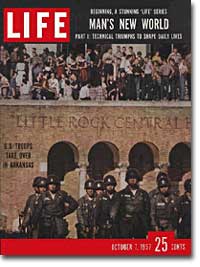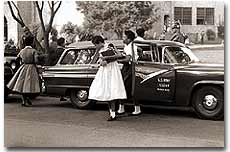54c. Showdown in Little Rock

President Eisenhower sent the 101st Airborne to Little Rock, Arkansas, to ensure the integration of Central High School in 1957.
Three years after the Supreme Court declared race-based segregation illegal, a military showdown took place in Little Rock, Arkansas. On September 3, 1957, nine black students attempted to attend the all-white Central High School.
Under the pretext of maintaining order, Arkansas Governor Orval Faubus mobilized the Arkansas National Guard to prevent the students, known as the Little Rock Nine, from entering the school. After a federal judge declared the action illegal, Faubus removed the troops. When the students tried to enter again on September 24, they were taken into the school through a back door. Word of this spread throughout the community, and a thousand irate citizens stormed the school grounds. The police desperately tried to keep the angry crowd under control as concerned onlookers whisked the students to safety.
The nation watched all of this on television. President Eisenhower was compelled to act.

To ensure their safety, African American students were escorted to Central High School in a U.S. Army car.
Eisenhower was not a strong proponent of civil rights. He feared that the Brown decision could lead to an impasse between the federal government and the states. Now that very stalemate had come. The rest of the country seemed to side with the black students, and the Arkansas state government was defying a federal decree. The situation hearkened back to the dangerous federal-state conflicts of the 19th century that followed the end of the Civil War.
On September 25, Eisenhower ordered the troops of the 101st Airborne Division into Little Rock, marking the first time United States troops were dispatched to the South since Reconstruction. He federalized the Arkansas National Guard in order to remove the soldiers from Faubus's control. For the next few months, the African American students attended school under armed supervision.
Can You Meet the Challenge?
This editorial by Jane Emery appeared in Central High student newspaper, The Tiger, on September 19, 1957.
You are being watched! Today the world is watching you, the students of Central High. They want to know what your reactions, behavior, and impulses will be concerning a matter now before us. After all, as we see it, it settles now to a matter of interpretation of law and order.
Will you be stubborn, obstinate, or refuse to listen to both sides of the question? Will your knowledge of science help you determine your action or will you let customs, superstition, or tradition determine the decision for you?
This is the chance that the youth of America has been waiting for. Through an open mind, broad outlook, wise thinking, and a careful choice you can prove that America's youth has not "gone to the dogs" that their moral, spiritual, and educational standards are not being lowered.
This is the opportunity for you as citizens of Arkansas and students of Little Rock Central High to show the world that Arkansas is a progressive thriving state of wide-awake alert people. It is a state that is rapidly growing and improving its social, health, and educational facilities. That it is a state with friendly, happy, and conscientious citizens who love and cherish their freedom.
It has been said that life is just a chain of problems. If this is true, then this experience in making up your own mind and determining right from wrong will be of great value to you in life.
The challenge is yours, as future adults of America, to prove your maturity, intelligence, and ability to make decisions by how you react, behave, and conduct yourself in this controversial question. What is your answer to this challenge?
The following year, Little Rock officials closed the schools to prevent integration. But in 1959, the schools were open again. Both black and white children were in attendance.
The tide was slowly turning in favor of those advocating civil rights for African Americans. An astonished America watched footage of brutish, white southerners mercilessly harassing clean-cut, respectful African American children trying to get an education. Television swayed public opinion toward integration.
In 1959, Congress passed the Civil Rights Act, the first such measure since Reconstruction. The law created a permanent civil rights commission to assist black suffrage. The measure had little teeth and proved ineffective, but it paved the way for more powerful legislation in the years to come.
Buses and schools had come under attack. Next on the menu: a luncheonette counter.






